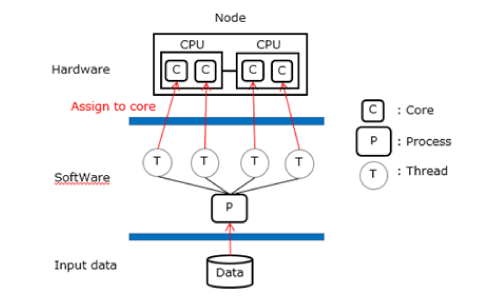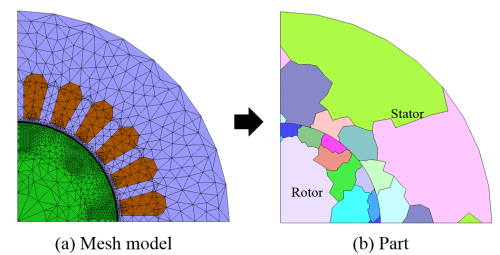Contents
1. Introduction
2. What is an SMP solver?
3. Evaluation of JMAG SMP solver performance
4. Summary
5. References
1.Introduction
The parallel solver is one way to run magnetic field analysis at high speed. JMAG has an SMP-parallel solver [1]-[3] that can easily be used with a single click on the computer.
The parallel solver is unique in that its performance varies significantly depending on the type of analysis data and hardware used. This White Paper presents the features and explains which type of analysis model is able to achieve parallel performance, as well as provide advice on selecting appropriate hardware.
2. What is an SMP solver?
The SMP solver gains speed by effectively using the multi-core installed in one node (one machine). It is often referred to as a “thread parallel” solver. The concept of parallel processing is shown in Fig.1. The input data (analysis model) is loaded into the software (solver), divided for processing of each thread, and then assigned to the core, which is where the calculation is run in the hardware. It is apparent that the parallel solver depends on the analysis model, the algorithm used in the software, and the hardware used.
Another characteristic of the SMP solver is that it cannot run parallel processing that requires communication across nodes. Therefore, the upper limit of parallelism is the number of cores in the machine.

Fig. 1 Concept of SMP Parallelism (example of 4-parallel processes)
3. Evaluation of JMAG SMP solver performance
As noted above, the performance of the SMP solver depends on the analysis model, software algorithms, and hardware. Of these, research on software algorithms was described in a previous JMAG white paper (reference [4]). Therefore, this white paper focuses on the evaluation of parallel performance when the analysis model is changed, and the change in parallel performance when different hardware is used.

Model divisions when using the parallel solver
Regions (parts) with different colors in the figure on the right are calculated by different cores.
You need to sign in as a Regular JMAG Software User (paid user) or JMAG WEB MEMBER (free membership).
By registering as a JMAG WEB MEMBER, you can browse technical materials and other member-only contents for free.
If you are not registered, click the “Create an Account” button.
Create an Account Sign in



